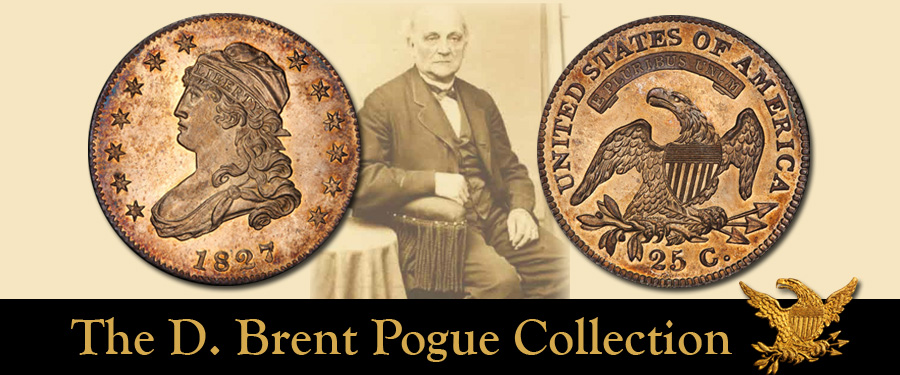
A Link With Tradition
Of all rarities in the American series, the 1827 quarter is one of the most famous, most storied. Joseph J. Mickley, a Philadelphia teenager, became interested in rare coins in 1816 when he attempted unsuccessfully to find a copper cent of 1799, the year of his birth (the very finest known 1799 cent, the Hines Collection specimen, will be in a later D. Brent Pogue Collection sale). His interest piqued, Mickley endeavored to learn about coins and, in time, built one of the finest collections ever formed.
Tradition has it that in 1827, he visited the Mint and for face value obtained four Proof quarter dollars. No one knew at the time they would prove to be great rarities. Some years later in the 1850s, when numismatics became a popular pursuit, the 1827 quarter was recognized as nearly impossible to find. Today there are fewer than 10 specimens known to exist. The Pogue coin, a Superb Gem Cameo MS-66+ is the finest graded by the Professional Coin Grading Service and stands alone at this level.
An Illustrious Provenance
As are so many coins in the Pogue Collection, this memorable 1827 quarter is an old friend. In 1980 we cataloged and offered it for sale as part of the T. Harrison Garrett Collection consigned to us by The Johns Hopkins University. We described it as choice in every respect. “It is fully brilliant with just the slightest hint of golden toning.”
Traditionally attributed as being directly from the Mint to Mickley in the year of issue, this 1827 quarter was later owned by Jeremiah Colburn, a Boston numismatist who in the 1850s was in the forefront of rare coin research. A prolific writer over a long period of time, in July 1874 he contributed this to the American Journal of Numismatics, a remembrance of a collector friend:
“Mr. Joseph J. Mickley, of Philadelphia, had a small collection of coins as early as 1818. He continued the pursuit until 1867, when he sold his collection to W. Elliot Woodward, of Roxbury, Mass., for $12,000, who sold it at auction at Messrs. Leavitt, Strebeigh, & Co.’s, New York, in October, 1867. It contained the rarest and finest specimens of American coins then known.”
The 1827 quarter in the Pogue Collection went from Colburn to John F. McCoy and was auctioned in May 1864 by W. Elliot Woodward as lot 508 in the McCoy Collection. Woodward was the most acclaimed professional numismatist of his era. This specimen next appeared in January 1884 as lot 244 in the Heman Ely Collection, also sold by Woodward. The coin went to George W. Massamore of Baltimore, who sold it to T. Harrison Garrett.
After Garrett’s passing in 1888 in a boating accident in Chesapeake Bay, his collection descended to his son Robert (who in the first modern Olympic Games held in Athens in 1896 was a gold medalist), then to another son, Ambassador John Work Garrett. The collection was then given to The Johns Hopkins University in 1942 and for years was on display at Evergreen House on North Charles Street in Baltimore. By the 1970s security had become so expensive that it was removed to storage in a bank vault downtown. The university then decided to sell the coins and use the funds to restore Evergreen House as well as for other projects.
When we auctioned this Gem 1827 quarter as lot 641 of the Garrett Collection, Part II, March 1980, it was purchased by Mack Pogue and his son Brent. Since that time—for 35 years—it has remained in the Pogue Collection.
The preceding narrative describes one of many Pogue Collection coins that is among the finest or the very finest of its kind and has a fascinating provenance adding to its appeal.





